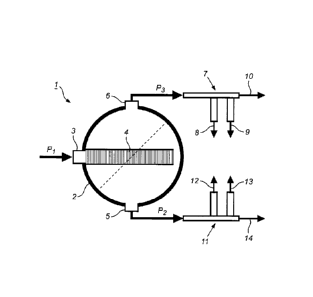Some of the information on this Web page has been provided by external sources. The Government of Canada is not responsible for the accuracy, reliability or currency of the information supplied by external sources. Users wishing to rely upon this information should consult directly with the source of the information. Content provided by external sources is not subject to official languages, privacy and accessibility requirements.
Any discrepancies in the text and image of the Claims and Abstract are due to differing posting times. Text of the Claims and Abstract are posted:
| (12) Patent: | (11) CA 2848495 |
|---|---|
| (54) English Title: | SPHERICAL SEPARATION DEVICE AND METHOD FOR SEPARATION |
| (54) French Title: | DISPOSITIF DE SEPARATION SPHERIQUE ET PROCEDE DE SEPARATION |
| Status: | Deemed expired |
| (51) International Patent Classification (IPC): |
|
|---|---|
| (72) Inventors : |
|
| (73) Owners : |
|
| (71) Applicants : |
|
| (74) Agent: | FASKEN MARTINEAU DUMOULIN LLP |
| (74) Associate agent: | |
| (45) Issued: | 2018-10-30 |
| (86) PCT Filing Date: | 2012-08-13 |
| (87) Open to Public Inspection: | 2013-03-28 |
| Examination requested: | 2017-02-22 |
| Availability of licence: | N/A |
| (25) Language of filing: | English |
| Patent Cooperation Treaty (PCT): | Yes |
|---|---|
| (86) PCT Filing Number: | PCT/NL2012/050562 |
| (87) International Publication Number: | WO2013/043042 |
| (85) National Entry: | 2014-03-12 |
| (30) Application Priority Data: | ||||||
|---|---|---|---|---|---|---|
|
The present invention relates to an apparatus for separation of high volume flows of mixtures provided with at least two immiscible phases, especially for the first separation steps of flows of water/oil/gas/sand mixture that enter the apparatus as a wellstream mixture. The invention also relates to a method for separation of high volume flows of mixtures provided with at least two immiscible phases.
La présente invention concerne un appareil pour la séparation de flux à volume élevé de mélanges comprenant au moins deux phases immiscibles, en particulier pour les premières étapes de séparation de flux de mélange d'eau/huile/gaz/sable qui entrent dans l'appareil sous la forme d'un mélange de flux de puits. L'invention concerne en outre un procédé pour la séparation de flux à volume élevé de mélanges comprenant au moins deux phases immiscibles.
Note: Claims are shown in the official language in which they were submitted.
Note: Descriptions are shown in the official language in which they were submitted.

For a clearer understanding of the status of the application/patent presented on this page, the site Disclaimer , as well as the definitions for Patent , Administrative Status , Maintenance Fee and Payment History should be consulted.
| Title | Date |
|---|---|
| Forecasted Issue Date | 2018-10-30 |
| (86) PCT Filing Date | 2012-08-13 |
| (87) PCT Publication Date | 2013-03-28 |
| (85) National Entry | 2014-03-12 |
| Examination Requested | 2017-02-22 |
| (45) Issued | 2018-10-30 |
| Deemed Expired | 2020-08-31 |
There is no abandonment history.
| Fee Type | Anniversary Year | Due Date | Amount Paid | Paid Date |
|---|---|---|---|---|
| Application Fee | $400.00 | 2014-03-12 | ||
| Maintenance Fee - Application - New Act | 2 | 2014-08-13 | $100.00 | 2014-07-17 |
| Maintenance Fee - Application - New Act | 3 | 2015-08-13 | $100.00 | 2015-07-20 |
| Maintenance Fee - Application - New Act | 4 | 2016-08-15 | $100.00 | 2016-08-03 |
| Registration of a document - section 124 | $100.00 | 2016-08-19 | ||
| Request for Examination | $800.00 | 2017-02-22 | ||
| Maintenance Fee - Application - New Act | 5 | 2017-08-14 | $200.00 | 2017-07-19 |
| Maintenance Fee - Application - New Act | 6 | 2018-08-13 | $200.00 | 2018-07-18 |
| Final Fee | $300.00 | 2018-09-19 | ||
| Maintenance Fee - Patent - New Act | 7 | 2019-08-13 | $200.00 | 2019-08-05 |
Note: Records showing the ownership history in alphabetical order.
| Current Owners on Record |
|---|
| SULZER CHEMTECH AG |
| Past Owners on Record |
|---|
| ADVANCED TECHNOLOGIES & INNOVATIONS B.V. |